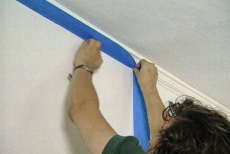RON HAZELTON: Our first stop this week is in the town of Northeast, Pennsylvania where Lucy Micks wants to add a special touch to her living room. Hey, Lucy.
LUCY MICKS: Here he comes, hi Ron.
RON HAZELTON: How are you?
LUCY MICKS: Fine thanks, welcome to our home.
RON HAZELTON: Good morning, and this is, good morning.
LUCY MICKS: This is Quincy Micks.
RON HAZELTON: Hi Quincy.
LUCY MICKS: Can you say hello to Mr. Hazelton?
QUINCY MICKS: Hello.
RON HAZELTON: Hello, so this is a gorgeous house.
LUCY MICKS: Thank you.
RON HAZELTON: When was this built?
LUCY MICKS: 1840. The main part of the house was built and then the front four rooms were added 20 years later.
RON HAZELTON: I love the detail up here.
LUCY MICKS: Oh, thank you.
RON HAZELTON: The leaves and all this. What are we going to do today?
LUCY MICKS: We are going to do some rag painting in the living room, so would you like to come in and see?
RON HAZELTON: I’d love to. Let’s see that room and the house.
LUCY MICKS: Come on honey, let’s go. Okay.
RON HAZELTON: Let’s go Quincy, show me the house, Quincy.
LUCY MICKS: This is the room, it had three coats of wallpaper that I had to strip off and start over and I wanted to combine some neutral tones that I have here in pillow, I had some taupe on the wall and I wanted to bring in these colors. So it is going to be very light.
RON HAZELTON: Yeah, it’ll be on the subtle side.
LUCY MICKS: Very much.
RON HAZELTON: Well you’ve done all the hard work. Took all the wallpaper off.
LUCY MICKS: Yeah.
RON HAZELTON: The painted finish that Lucy wants is a bit outside my expertise. I mean, you can’t know everything. So, I call in a friend who can show us both some tricks. Hey, how are you, good to see you again.
VICTORIA DENNIS: Hi, nice to see you Ron.
RON HAZELTON: This is Victoria Dennis, she is a (INAUDIBLE) finisher. Lucy, Victoria.
LUCY MICKS: Nice to meet you.
RON HAZELTON: An expert at these kinds of things. I have never done ragging before so show us how this is going to work.
VICTORIA DENNIS: Okay, it’s really very simple. If you could help me out with the paint and the glaze.
RON HAZELTON: Victoria mixes equal parts of latex paint and a water based glaze. The glaze keeps the paint from drying too quickly during the application. And also gives the finished wall a soft sheer look.
VICTORIA DENNIS: Lucy if I could have you just dampen a couple of rags for us.
LUCY MICKS: Sure, thank you.
RON HAZELTON: No brushes for us, we’re going to use damp cotton rags to dab on our finish. The trick to this technique is the perfect fold. A square cotton cloth laid out flat.
VICTORIA DENNIS: We are going to pinch it right in the middle.
RON HAZELTON: Pinched in the middle.
VICTORIA DENNIS: We are going to gather up all these corners. . .
RON HAZELTON: And then gathered into a rosette shape. Into the center.
VICTORIA DENNIS: Right into the center.
RON HAZELTON: Now, why are we doing this?
VICTORIA DENNIS: Well, this is going to give us our texture. This is actually what’s going to create our look on the wall.
RON HAZELTON: But before moving to the living room wall, we made some practice dabs just to get the feel of it. Okay Lucy, why don’t you grab a tape, let’s go in and get the room ready.
LUCY MICKS: Great, let’s get started.
RON HAZELTON: After removing all of the living room furniture, we used a low-tack masking tape to protect the trim. Then it was time to put our new skills to work.
VICTORIA DENNIS: Okay, are we ready to begin on our rolls?
RON HAZELTON: I am rosetted up, are you guys rosetted?
VICTORIA DENNIS: Everybody’s got their rosette?
LUCY MICKS: Here we go.
VICTORIA DENNIS: Okay. Now, let’s remember how we do this, we want to dab into the paint and now we are going make our faces on the wall, so we’re going to do our two eyes and our nose.
RON HAZELTON: Two eyes and a nose.
VICTORIA DENNIS: Excellent. Now remember we want to pull this out kind of far, don’t work too tight right away.
RON HAZELTON: Learn from my last mistake, so you want to put some space, some white space between these.
VICTORIA DENNIS: White space in there, that’s right. Now you can go back over and soften your areas and don’t worry, we’re going to fill these in.
RON HAZELTON: Now, I think my first two or three here are a little bit darker, so if I want to lighten those up would I just sort of hit it a little more?
VICTORIA DENNIS: You are just going to keep going over them, but you are not going to go right over the same spot, you might dab on here and then go up to a white area to take some of that off of your rag.
RON HAZELTON: Okay, so I can transfer it from there to there.
VICTORIA DENNIS: That’s right.
RON HAZELTON: There to there.
VICTORIA DENNIS: Move it around. How are you doing Lucy?
LUCY MICKS: I think it’s.
VICTORIA DENNIS: Oh, that’s perfect.
LUCY MICKS: Coming out pretty well.
VICTORIA DENNIS: Just perfect.
RON HAZELTON: As we start to make some progress, it becomes clear to me that maybe I should have practiced my ragging a little bit longer. Does this qualify as a clean rag or am I too dirty now?
VICTORIA DENNIS: No, I think that you are just fine. What you don’t want to use are these saturated areas, you want to use some of your lighter areas. Make sure you ball that up so one of those are showing.
RON HAZELTON: And that wasn’t the only problem. But, but, but look, Lucy’s area over here is very different than my area, but you are saying this is okay?
VICTORIA DENNIS: That’s right, but what I may do is I may come back in and do a few little touch ups here and there, but in general we want to see all the different textures that the rags can make. And as you can see I am working this over here right close to the edge now, one of the nice things about rag painting is that you can since you have a nice soft rag, you can simply lay that right against the edge and press it in there straight and it’s just as simple as that.
RON HAZELTON: Now, let me ask you something. If we just didn’t like this at all, I mean, it would just be a matter of rolling the base coat back on again, right, cover everything up?
VICTORIA DENNIS: Well that’s correct. This is just a latex product that we’ve used, so all we have to do is go right over the top with latex again which was our base coat and then we can start all over again from scratch.
RON HAZELTON: So, Victoria, how long’s it going to take us to do the whole room, you think?
VICTORIA DENNIS: Well, it’s hard to say exactly how long it’ll take, but I think that we’re going to be finished before suppertime tonight.
RON HAZELTON: Well do you eat supper early or late? Well as it turned out we could smell supper on the stove as we finished that final room corner.
VICTORIA DENNIS: Well Ron, that’s the last of it.
RON HAZELTON: Okay, let me take a look. You know, I like this. I really, really like this.
LUCY MICKS: I do too.
RON HAZELTON: You know if you want to do this kind of a wall treatment to your own home, let’ s just recap for a second the steps that we went through. Now Lucy tell us how you prepared the walls.
LUCY MICKS: I had to remove the wallpaper and then put two coats of base paint on.
RON HAZELTON: Okay, and Victoria if you’d kind of just go over what we did today.
VICTORIA DENNIS: Sure, well if you remember, we made our special glazing mixture. And we prepared our rags. We came in and taped the room and we were able to put on our application.
RON HAZELTON: Now keep in mind if you are going to do this, both the paints that we used, that’s the base coat and for the glaze, were satin sheen, stay away from the flats. I don’t know about you guys, but I feel like I’ve added a new skill to my tool bag. Thanks so much, Victoria.
VICTORIA DENNIS: Thank you it was a pleasure.
RON HAZELTON: Lucy you were great.
LUCY MICKS: I appreciate it.
RON HAZELTON: Maybe one high five guys for the road? Okay.













